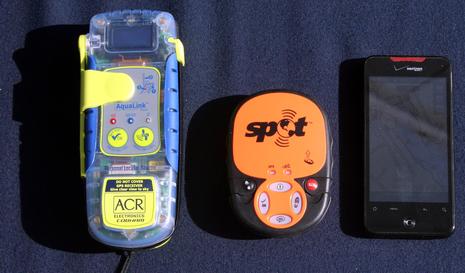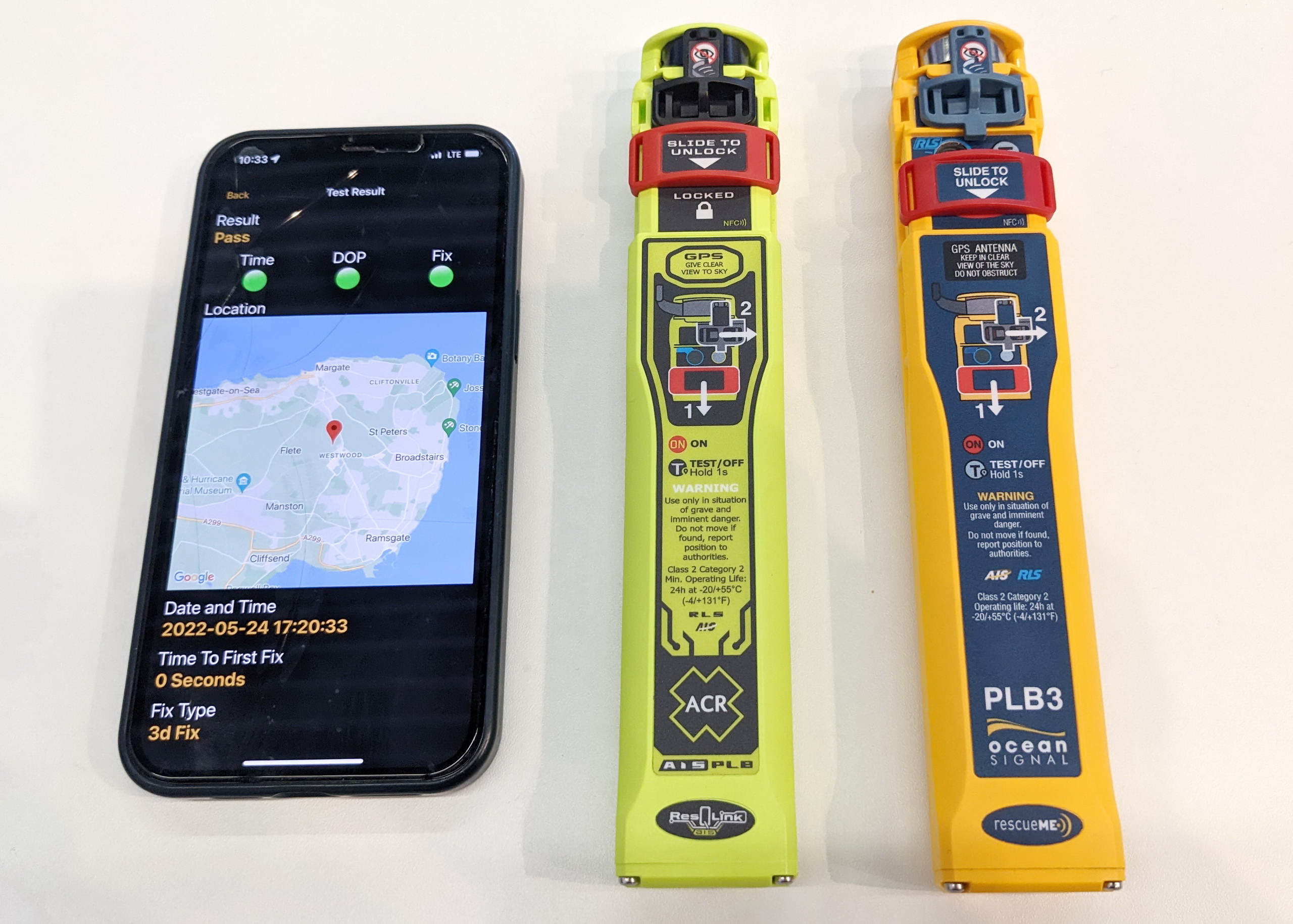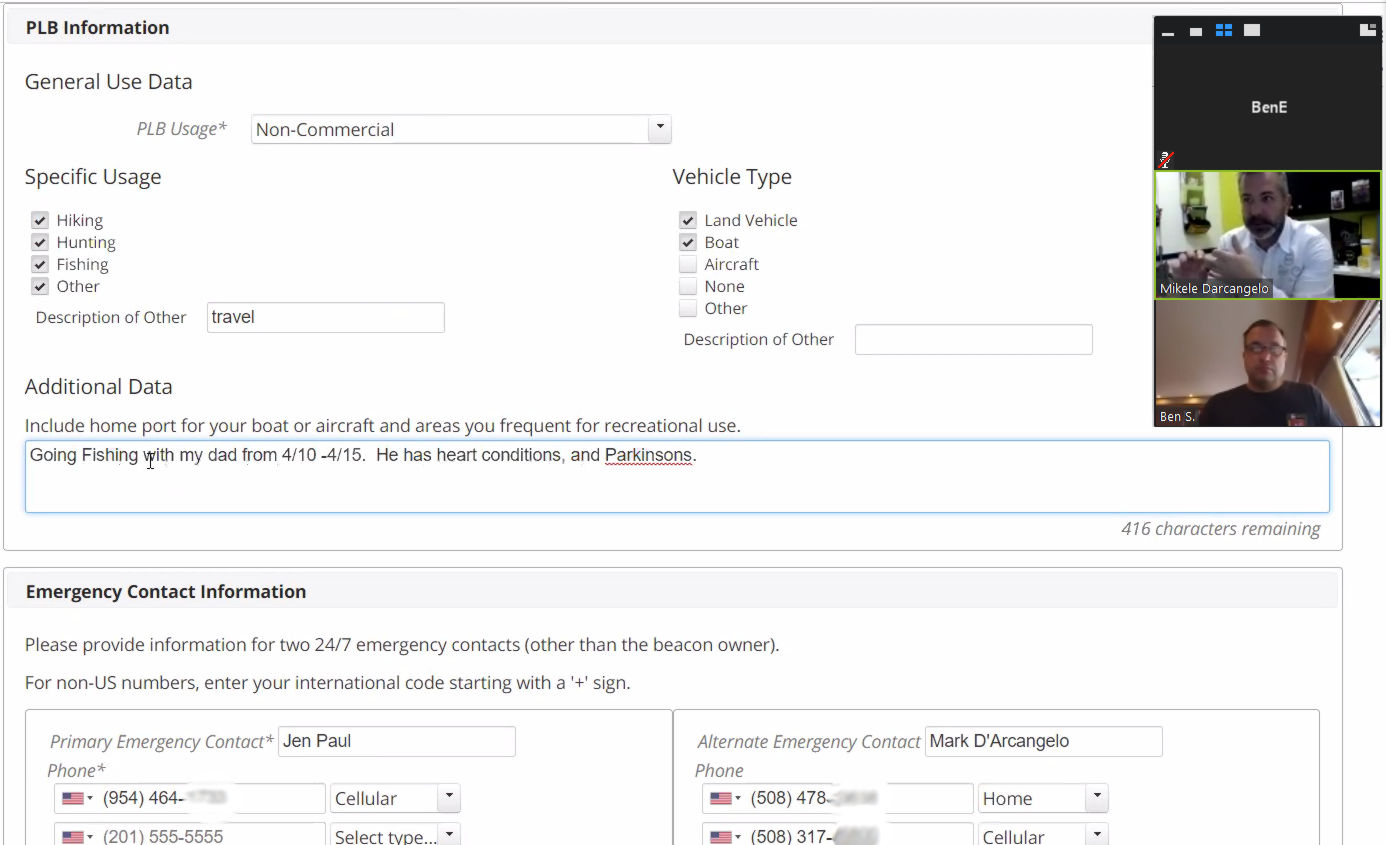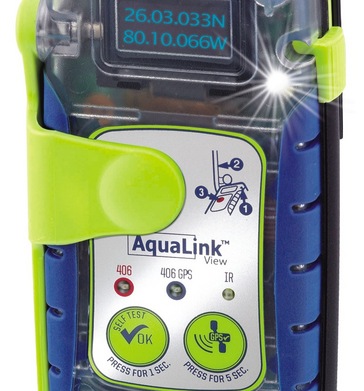ACR Aqualink View & 406Link, hand’s on
The first time was the best. I was tootling down the Bay in May when I tested the ACR AquaLink View PLB. I’d already appreciated its high build quality, and how neatly instructions about how to activate its two self test modes and primary distress function are explained right on the casing. Then when I pressed the GPS Test button for five seconds, it was very nice to have the small LCD screen show the procedure step-by-step and advise me to give the antennas a good sky view. And it was impressive that the GPS — perhaps never used before, or at most tested in Florida — got (and displayed) a position in well less than a minute. (In fact, the whole test procedure is so quick that I’ve had a hard getting a good photo with the scrolling screen in action.) But the kicker was how my cell phone buzzed a moment later with a text message confirmation that the beacon’s test signal had made it through the COSPAS-SARSAT satellite system, along with a link to its accurately mapped position…
Because I’m also testing the Pro version of ACR’s 406Link service, the same “All’s well” short message and location link could have been emailed and/or texted to four other recipients. Frankly, though, I consider that Spot-like messaging feature quite secondary to the reassurance felt when you can test a critical safety device like this PLB all the way through the system (short of the rescue center). I also like how the 406Link user site keeps track of beacon tests, battery life, etc., as shown in part below. Note that the service is available to some degree for many brands and models of PLBs and EPIRBs, depending on their test capabilities…and the offer of one free test is still in effect.
But note also that I’ve tested the Aqualink View ten times, not eight as recorded at 406Link. Twice early this summer I ran tests while standing on Gizmo’s extended top with what seemed like a good sky view though she was tied up at her Camden float. I didn’t think that was huge deal, because the weakness of through-satellite PLB/EPIRB testing is that only a single 406mHz data burst is sent, but perhaps the difficulty of explaining that is why I went on to other testing for many weeks (so many gizmos, so little time). At any rate, I did six tests yesterday — three with GPS, and three without, including one of each from my float — and they all went through fine. I also spoke with ACR this morning, and it is possible that my failed tests happened when their relatively new 406Link ground station was off line. Most 406Link support calls they’re taking end up being caused because the user tried the test indoors or didn’t put in the right cell service for texting, etc. But they also said that during real distress activations, when a PLB/EPIRB sends that 406mHz burst every 50 seconds for hour after hour, the records often indicate that a few bursts got lost in that 44,000 thousand mile plus trip from beacon to geosyncronous satellite to earth. In other words, a failed through-satellite test doesn’t mean your PLB or EPIRB has failed. Try again!
Understanding the slight uncertainty of the test burst makes the little screen on the AquaLink View (and its iPro EPIRB sibling) even more valuable, I think. Given that plus the built-in flotation, extra transmit power, extended battery life, and much more, I most definitely stand by the idea, expressed when the product was introduced, that this is “the most sophisticated and best performing PLB ever designed.” But it is not the smallest or least expensive PLB ever designed…
The photo below illustrates size differences between the AquaLink, Spot2, and my Droid Incredible. A FastFind 210 PLB would cast a much smaller shadow than the AquaLink, and the Spot2 is a much better messaging and tracking device (though I’m finding it to be a bit of a battery hog). I plan to keep testing the AquaLink, particularly in harsh weather, and will report in comments here. But I’m not going to fret much if it misses a through-satellite burst or two; as far as I’m concerned the extra size and cost are well worth it.















Incidentally, I learned from ACR that the AquaLink View does not save GPS position from a test, which means its doing a dead cold start every time I test it. Its 66 channel GPS engine is fast!
not much use to us Eurup -eans at the moment
Dave
Right, Dave, in terms of 406Link, because so far they can only pick off test bursts coming down from two of the GEOS satellites. Though the coverage maps suggest that Portugal might get service and “coming soon” is emblazoned elsewhere:
http://www.406link.com/Coverage%20Map.html
Of course the AquaLink View, like all PLBs and EPIRBs, should work anywhere thanks to the GEOSAR and LEOSAR constellations:
http://www.cospas-sarsat.org/index.php?option=com_content&view=article&id=180&Itemid=101&lang=en
It is not obvious in your article that the test email feature is a fee based service @ $39.95 per year (currently).
Gary
Sorry about that, Gary. Actually the Plus service is $60 annually; Basic is $40.
Always wondered what the difference was between the AquaLink View and the SARLink View. Only difference I can pinpoint is the SARLink View is slightly smaller and does not float.
I’ve got to ask the question, If you’re using this service every day for extended trips, what’ts going to happen to your battery life when you have a real emergency ?
Keith, As explained at 406Link.com, the AquaLink View is designed so that you can do up to 60 tests with GPS, plus 420 tests without GPS, while still maintaining at least the minimum 24 hours of emergency use (even at a -4°F) for five years. In other words, they built extra battery capacity in.
As I understand it, the AquaLink will refuse to do more than 60 GPS tests until its battery is replaced. I’m not sure if it will do more than 420 self tests without GPS, but the self testing does include battery status.
406Link.com advises users of other than ACR beacons to ask their manufacturer about the number of tests possible. I don’t think these tests use much juice sending up a single data burst, but certainly the messaging/tracking capability is pretty limited.
The manufacturer is advertising it as a ‘Honey, I’m ok Button’.
So if it’s not a test but the regular emercency signal, will it text ‘Honey, I’m NOT ok’ to the wife? 😉
The email/text notifications only work for self tests, but if you’ve filled in the right contact info with your beacon’s registration, the rescue center will probably be in touch with your family. 406Link also lets you put up emergency contact info, but as I understand it, that’s only used if a user failed to register the beacon.
Is there a PLB that sends a mark to appear on your plotter as to where the overboard person is located? Or are they just independent EPIRB’s?
Thanks for your time.
Mik
Mik, there are various devices that can alarm on and home in on the 121.5 mHz signal of any EPIRB or PLB, but I don’t know of one that also signals an electronic navigation system. The ACR Vecta 406 is an example:
http://www.acrelectronics.com/products/catalog/direction-finders/vecta-406/